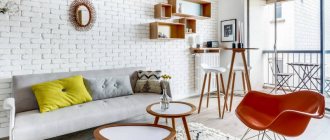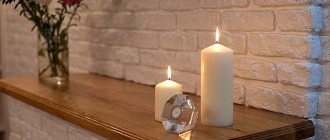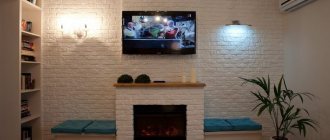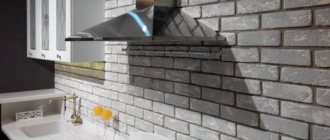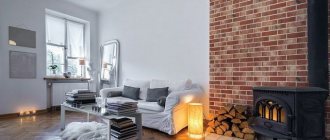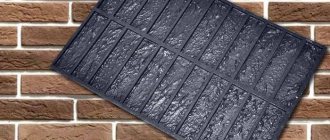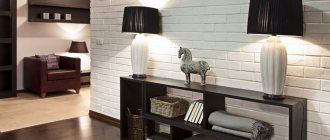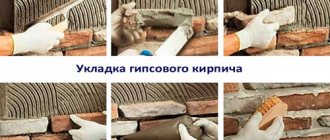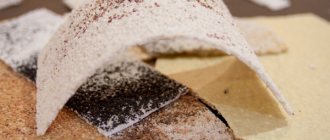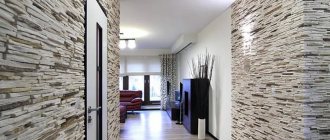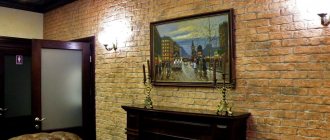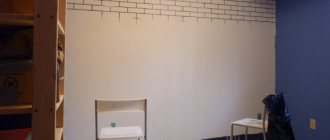Gypsum is a soft, plastic and lightweight material, and these qualities determine the popularity of finishing materials made from it. Decorative tiles, the raw material for which is gypsum, are very popular; there are a huge number of texture and format variations. How not to make a mistake when choosing a manufacturer? Is it possible to make gypsum tiles to look like stone or brick yourself? What is the laying and grouting technology? We will consider all these questions further.
Features of gypsum tile products
Gypsum is one of the widely used building materials. Used mainly in interior design, as surface materials for walls, ceilings, stucco. Decorative parts are made from it:
- sockets for a chandelier;
- internal cornices;
- ceiling frames;
- decorative columns and much more.
Gypsum tiles always look beautiful in the interior
Gypsum is also used to imitate plaster. It is also produced as prefabricated block, such as drywall.
Gypsum is a white to gray mineral found in the earth's crust. Chemically it is known as calcium sulfate hydrate (CaSO4.2H2O), which is obtained by extraction from large veins. For interior decoration, a translucent gypsum stone called alabaster is usually used; it is suitable for any sculptural forms. In its natural state it consists of about 30% bound water. This water is extracted through continuous heating to obtain a white powder.
Has many design advantages
For the manufacture of gypsum tiles and other gypsum materials, it is this naturally occurring gypsum that is used as a raw material . So-called synthetic gypsum is made from it. This is done using wet limestone, which is a combination of calcium and water, combined with sulfate to form calcium sulfate.
How is plaster different from other surfaces?
Among its qualities there are unique ones, in particular the following:
- has no foreign odors, completely safe;
- widely available in nature;
- comfortable, aesthetic material;
- easy to install;
- fire resistance;
- durability;
- sound insulation;
- heat resistance.
This material is fire resistant and durable
Nowadays, most interior and exterior design features are mainly controlled by gypsum construction or gypsum molding.
The demand for this material is due to another factor: less time, cost of work. Over time, gypsum products acquire more and more advanced properties, such as increased fire resistance, acoustic properties for sound insulation, etc.
Gypsum tiles - easy to install
Properties
Fire resistance
It is naturally fire resistant, stopping the spread of fire, which can be critical to safety and life. This property is due to the presence of water, which is present in gypsum products. Let's say a 15 mm thick gypsum tile contains almost 3 liters of crystallized water. As the fire approaches the water, the water undergoes evaporation, resulting in a protective layer that covers the gypsum product. This property will help stop the spread of fire from other materials.
Good sound insulation
Non-flammable
As explained, heating gypsum products causes the water crystals present in the gypsum material to heat up.
This dehydration of gypsum by heat is called calcination. Firing results in a coating that prevents it from burning, allowing the material next to it to maintain a lower, safer temperature. Even after the water crystals are completely calcined, the residue will act as an insulating layer until it is destroyed. Gypsum is considered a good fire retardant due to its ability to stop the spread of fire for several hours depending on the amount of gypsum products.
Has no foreign odors
Acoustics
Gypsum products are famous for their soundproofing properties, which are much more effective than brickwork, if we take the same thickness. Gypsum is specially formulated to reduce noise and prevent reverberation. The space between two plaster walls results in higher acoustic performance by limiting the passage of noise. For example, instead of a 110mm thick brick wall, we can install 75mm thick gypsum boards to achieve the same sound performance.
Can be matched to any style
Heat resistance
The thermal properties created by the gypsum structure will ensure a good balance of humidity and temperature in the room. Gypsum construction incorporating cavities such as plasterboard or formwork provides additional insulating properties.
Vapor barrier
The use of gypsum boards in interior design prevents humidity in the room.
Can be used in any room
How to make panels yourself
It is quite obvious that if you want to save money, then almost any product can be made yourself. Of course, the result is not always perfect, but it depends on accuracy and patience.
Gypsum panels with a 3D effect for walls require adherence to production technology. To work you will need the following components:
- Water at room temperature.
- Lime.
- Molding plaster.
- Fiber fiber. It must first be soaked in water.
Materials required for the manufacture of gypsum 3D panels
For such work, the required ratio is selected. For example, for 7 parts of water there is one part of lime, 8 parts of gypsum.
The process of preparing the mixture is divided into several stages:
- Lime and fiberglass are mixed in a container.
- Water is added.
- The solution is thoroughly mixed with a drill fitted with a mixer attachment.
- Gypsum is added.
- Stirring is repeated. You need to get a mixture without lumps.
- The resulting composition is poured into the mold.
- Complete hardening occurs within an hour.
Of course, for larger-scale production of 3D panels you will need many forms and a drying rack.
For self-production of panels, special molds are required
It should be borne in mind that the characteristics of DIY panels are similar to those sold in stores. But they cannot be used for installation on a wall in a bathroom or shower room.
Plaster walls
Gypsum walls are durable, paintable surfaces that are suitable for all types of interior spaces. The material does not contain volatile organic compounds (VOCs). Thanks to its structural diversity, it perfectly shapes the atmosphere, tone, and mood in a home or office.
Gypsum wall tiles are made to virtually any design, pattern or texture using a CNC manufacturing process. They can match any decor. The design can be calming for a casual living room or more dynamic for a business office environment. It can be subtle, lively, upscale or trendy.
The variety of materials will surprise you
Finishing methods
The material in question is an elongated tile, the shape of which resembles one of the projections of a brick. Usually its length is 18-24 cm, and its height is 7-15 cm. The thickness of such a gypsum product is 20-25 mm. The manufacturer, in principle, can produce tiles with other sizes.
Gypsum tiles vary in surface type and texture. There are “bricks” with a matte and glossy surface, as well as those imitating “old” brick. A special type is made up of products with a relief pattern.
Installation of tiles can be done in several ways:
The choice of finishing method depends on the specific conditions and the chosen design style of the overall design of the room.
Accent 3D walls
This is not yet a hackneyed way of decorating houses and apartments, which fashion designers have already adopted. 3D wall panels can complement almost any indoor residential or commercial environment, helping to create a colorful living space. This is a modern, simple, economical finishing material that can be quickly installed and painted in any color to match the interior.
They can be used to create accent walls, TV background walls, bedrooms, children's rooms, offices, restaurants, entertainment centers.
3d panels on the wall
What do they represent?
These are relief composite tiles with a complex single pattern that provide a three-dimensional finish in the interior, sold by square meters. Each piece measures approximately 60/60 cm, but other formats are possible. The design principle is to give a smooth monolithic surface without joints or seams, so each part is made to fit into the neighboring one.
Designers love this new, unconventional material and suggest decorating an accent wall with it to make it stand out as the central focal point of the room. But some people use tiles to cover all the walls or ceilings.
You can sheathe not only the walls, but also the ceiling
Coating texture
You can choose any repeating geometric pattern or make a sketch yourself - for this there are already quite advanced technologies that allow you to implement personal projects of volumetric walls based on gypsum.
The most common patterns chosen are waves, honeycombs, circles, pits, moons, and ripples. You can get a very realistic imitation of a brick wall and other surfaces.
The material can be painted in any color. That is, you choose not only the shape for your wall, but its color range to the desired shade. You can also repaint such walls, even several times. They can also be artificially aged, for example, using the craquelure or patina technique.
Has a wide variety of patterns
You can install such panels yourself . The joints are made with micron precision, so that all parts come together in one stunning pattern, without any visible tile boundaries. To create one large seamless textured wall, adhesive is applied to the back of the tiles using a trowel and then installed.
There is a thin layer of putty on the end of the tile. When joining sheets, an additional fastening element appears, which is used to seal the seams between the panels. Subsequently, the seams are rubbed down and a monolithic surface is obtained.
You can install such panels yourself
So, step by step, the three-dimensional gypsum panels are glued to the entire wall. If you need to cut a sheet, this can be easily done with a regular saw. Since the material is quite fragile, you need to be careful when working with it, protect it from falling.
Thus, you can get a designer wall in your interior without the participation of a professional decorator. Add a sculptural panel to the wall to add decoration and texture. Paint your 3D wall any color you want, using household paint, tone on tone, or to contrast with your existing decor.
Waves are a very popular pattern
Tip To make the most of the sculptural effect, try lighting the wall from above or below to highlight the 3D effect and textured surface.
3D panels in the living room interior: photo
The interior of the living room should be attractive, functional and provide all our needs. The living room in our homes serves a number of different important functions. Before you feel like a serious interior designer, first ask yourself: what will you do in the living room, why do you need it?
The living room can serve several functions. There you can relax, watch TV, read, receive guests, have dinner together and sometimes just sleep.
Thus, when choosing a decorative wall covering, be sure to think about how it will suit all your needs, not just focusing on impressive effects.
Waves of various types have firmly established themselves in living rooms of different styles and trends.
Prevailing trends in wall decoration
It is not difficult to notice that 3D panels, like other textured finishing materials for the living room, are gaining popularity in individual construction. Moreover, there are more and more models with interesting non-standard geometric shapes, in contrast to the already familiar waves. Some designers believe that the wave is already a bit of a hackneyed motif.
Another bold decision. The bright black and geometric motifs of the structure are not off-putting. And additional lighting and white furniture smooth out the expression of black
Black color in decorative finishing has found its admirers and this is clearly visible in a noticeable trend in modern design. Along with calm, smooth and quiet colors, black bursts into the interior, capturing more and more space.
The living room wall of intense black color with a pattern reminiscent of the speakers of an audio system will not leave anyone indifferent
Three-dimensional designs keep up with the popular trend towards minimalism and the feeling of unfinished renovation work. And the currently fashionable type of concrete wall finishing can be easily implemented using the existing offers from a wide range of manufacturers. In fact, all this is very much reminiscent of ordinary gypsum fiber board - gypsum fiber sheet. However, the desired effect is achieved without problems.
The living room looks very cozy thanks to the combination of concrete slabs and warm wood
Modern finishing materials are a source of inspiration for interior designers and architects. People love to be in an individual, non-standard environment. They want to have something that sets them apart and makes their home something special. 3D panels are a great way to organize your living room. In order to create a unique, truly inimitable atmosphere, you can safely choose this solution for interior decoration.
A rich brown finish with a surface reminiscent of desert dunes combined with interesting lighting transforms the living room into a luxury hotel
The walls in the living room are an important element of an impressive interior. Characteristics such as shape, texture and color determine the visual perception of the entire space. White or beige light gray fits perfectly into these frames. However, if you are someone who prefers bright colors, make one accent wall using non-standard 3D panels.
To get an intriguing effect, you don’t have to cover a large area - sometimes small but well-placed details make all the difference
Dropped ceilings
The modern suspended ceiling system has not changed much since the 1960s and is still the most common type of ceiling used in the design of commercial and residential buildings. It has many strengths, which include low price, flexibility, quick installation, acoustic properties, adaptability for lighting and mechanical systems, and easy access to the plenum.
Typically, they were used to conceal mechanical systems such as ducts and pipes, giving the overhead space a clean, monolithic appearance. Today, the open ceiling trend is more popular, especially in commercial interiors, despite the benefits of gypsum ceiling systems.
Looks good on the ceiling
Research has shown that adding design elements to the ceiling plane can have a significant impact on the overall ambiance of a space, and can create a feeling of openness, privacy, intimacy or even energy. Additionally, a life cycle analysis study of ceilings versus open styles found that while initial installation costs are higher for suspended ceiling systems, energy and maintenance costs are lower than with exposed designs.
Suspended ceiling systems using gypsum ceiling tiles present a huge opportunity for designers and architects to create impact and visual interest in interior decoration, as well as solve a number of performance, safety, and overall appearance issues.
Main characteristics
Gypsum ceilings are a ceiling structure made of tiles, panels or blocks that can be adjusted in height for easy installation of all types of pipes, insulation materials, heating and lighting devices. They are also easily adaptable to special construction requirements such as:
- round ceilings;
- domes;
- sloping ceiling;
- recessed lighting, etc.
Stucco decor in the interior
They are a secondary structure that is attached to the main ceiling. It is a compatible independent structure, ready to paint, lightweight, excellent sound absorption, fireproof, economical. In addition, gypsum ceiling tiles with plastic coating on the front side and aluminum coating on the back side are durable and wear-resistant. It can also be washed with regular household detergents. Offers good sound insulation, water repellency and paint that will not fade when exposed to direct sunlight.
Gypsum ceiling design
Repeating modules (panels, slabs, blocks) are suitable for any shape and can be trimmed if necessary. Such a ceiling will improve indoor air quality and will be easy to use and install.
Installation principles
The suspended ceiling is slightly lower than the main one, this allows you to hide all the wires from the chandeliers and effectively place spot, recessed lighting. Installation takes place according to the principle of a frame system. After installing the frame, work with electrical wiring and connecting future lighting with the output of the corresponding wires follows.
Installation takes place according to the principle of a frame system
The frame may consist of square or rectangular divisions, depending on what type of architecture and design is needed . Sometimes ceiling tiles are cut to accommodate irregular or round light fixtures. In other cases, it may not be necessary to use tiles in place of the lighting fixture. In the third case, they buy a special ceiling rosette made of plaster, used for chandeliers. When choosing ways to place lamps, most designers are guided by specific needs.
One of the many advantages of this material is the ease with which it is installed in new or existing premises. Installation on the frame occurs in a very short period of time without loss of acoustic or insulating characteristics.
Lightweight and easy to care for
Most tiles do not require special cutting tools and are compatible with a variety of adhesives and installation methods. Additionally, many products come with a removable layer for added protection during installation.
The ceiling can radically change any interior
Finishing examples
Different wall designs are achieved in several ways:
Gypsum tiles help give the interior of an apartment or private house a special appearance. It fits harmoniously into various design styles.
You can cladding the walls yourself, using the recommendations of specialists. Making tiles yourself at home will help reduce the cost of finishing work.
Source
Wall plates
Any base is suitable for laying decorative tiles. Combine a series of panels or tiles into a continuous pattern. The seamless pattern can be positioned vertically or horizontally, this is reflected in the instructions. When installation is complete, the gap between the panels will not be noticeable. What to consider when installing wall slabs:
- If necessary, use the tile as a separate insert or decoration. Fill a certain space with it, not necessarily the entire wall. The size of the installation is limited only by your imagination and the room's capabilities.
- Painting the surface maximizes the tile's capabilities, as its fine-grained structure absorbs and transmits color well.
- Carefully unpack each panel for installation, allow it to acclimate to ambient temperature and humidity, and prepare it for painting to achieve the desired effect.
- Or order pre-painted wall panels. Factories and companies will professionally paint the product in any color, including beautiful metallic shades of water-based paints. However, pre-painting is not suitable in cases where a seamless installation is required. Choose this method only when it is essential to save time and effort. Painted panels perfectly reflect mood and atmosphere and are especially suitable for high traffic areas.
Wall plate option
With the right texture and color, the stimulating effect increases if you need to get some action from those present:
- decide to purchase or cooperate in commercial establishments;
- eat a lot or little in the kitchen (for a good appetite, choose red paint, and for those who are losing weight, blue is suitable);
- increase creativity and productivity.
At home, you can make rooms more energetic and lively, less busy, or casual and relaxed.
White color makes the room more spacious
Color is important to any design scheme. Bright colors like red and yellow add energy, while blue, green and other cooler colors create a calming effect . The versatility of grey, white, black and brown provides the flexibility to create effects when complementing other colours.
Materials
Gypsum boards are composed of medium-density fiberboard (made from recycled wood) and porcelain gypsum. Sulphate mineral (gypsum) is often used for plaster and wall coverings. The grade of gypsum used in panels and slabs for home interiors is usually alabaster, a fine-grained white/lightly tinted gypsum material. It is a flexible material used for sculptures and can be processed into any type of paint or texture.
Options for using gypsum tiles
Guaranteed quality
The production of panels is carried out in accordance with the latest German developments. A multi-stage control system for all processes has been introduced, the quality management system is certified according to ISO 9001. All this allows us to produce 3D gypsum panels with a unique porcelain effect - due to the increased density of the material, bubbles do not form in it, the surface is smooth and does not stain your hands. Using our own durable casting molds guarantees the ideal geometry of each finished product, making it possible to create monolithic compositions of unlimited sizes without visible seams or noticeable transitions. The depth of the relief is guaranteed to be the same for each panel of one collection.
Can be used in any interior
You can buy decorative panels for your home, office, store or other object made in the style of Baroque, Art Deco, minimalism, steampunk, hi-tech and others. Our catalog includes a wide range of products that can be used alone or in combination with wood, leather and other decor. At the same time, in any interior, our panels remain the center of attraction and create a positive atmosphere. Depending on the wishes of the customer, during installation the craftsmen can paint the products in any color from the catalogue.
Safety
We produce gypsum 3D panels for walls from safe highest grade gypsum, without admixtures of alabaster, plasticizers and other foreign substances. Our products are environmentally friendly and do not increase background radiation, unlike most concrete products. Artpole panels are non-flammable (fire hazard class KM0), so they can be used even in fire escape areas.
Ease of installation
Finishing with Artpole panels does not take much time: ideal geometry, detailed instructions and light weight significantly reduce the labor costs of craftsmen. Thanks to the repeating of the decor on the back side, our panels weigh less (they can be held with one hand), reduce the load on the floors, so when finishing there is no need to waste time on additional reinforcement. A number of models from our range can be mounted on any base, without preliminary preparation. The ideal geometry allows the panels to be laid as a monolithic fabric without seams, creating exclusive decors.
If you have any questions about Artpole 3D gypsum wall panels, ask our specialists at one of our toll-free phone numbers. You can personally view the collections presented on the website in our company stores in Moscow or at our partners in different cities of Russia and other countries.
TECHNOLOGY: In the summer of 2012, a new Russian production of gypsum panels ARTPOLE was opened. When creating the production line, the latest German developments were used, which make it possible to produce gypsum panels with the “Porzelan Plaster” effect (gypsum with a porcelain effect), which have no analogues in the world. The technology was introduced in collaboration with leading Russian specialists from the Mosstroy Research Institute.
ABOUT THE PRODUCT: In this catalog we present new collections of 3D decorative wall panels for interior decoration Artpole, made of gypsum using unique German technology.
Benefits of gypsum
To summarize, here are some of the strengths:
- provides a smooth surface without cracks and chips, which are easily masked with plaster in the same way as seams;
- using lighting you can increase the volumetric effect;
- air circulation in the room. The natural origin of the material provides a natural ability to regulate the climate and humidity in the room;
- provides good aesthetic and functional features;
- due to the low price, you can even make a professional project with a designer at an affordable price;
- many amazing design options;
- ease of installation;
- Gypsum plaster can be used as a final finish without the use of paint. The white finish gives a clean look.
interior of the apartment, interior design.
VIDEO: How to lay and paint gypsum stone?
Gypsum tiles in the interior
Imitation of unpainted tiles
Results
Yes, decorative tiles have a wide range of applications. But do not forget about the disadvantages when choosing material for cladding. You should take into account not only how appropriate gypsum will be in the interior idea, but also the quality of the purchased material.
When planning your work fireplace surround, take your time when choosing a good material manufacturer. Otherwise, you could end up spending a lot of money on low-quality material that will peel or crack when heated. It would be a good idea to apply a double layer of glue to the surface and to the slab. This will increase the level of adhesion and guarantee the durability of the cladding.
Choosing grout!
Not everyone knows that grout has a dual purpose: the first and main purpose is to protect the base under the tile, the second is aesthetics.
If you use moisture-resistant slabs, soil, waterproofing materials, etc., the type of grout will not play a big role. Any high-quality cement grout with a mineral filler will be suitable for sealing joints.
If you are still in doubt, use a two-component epoxy grout, which costs a little more.
